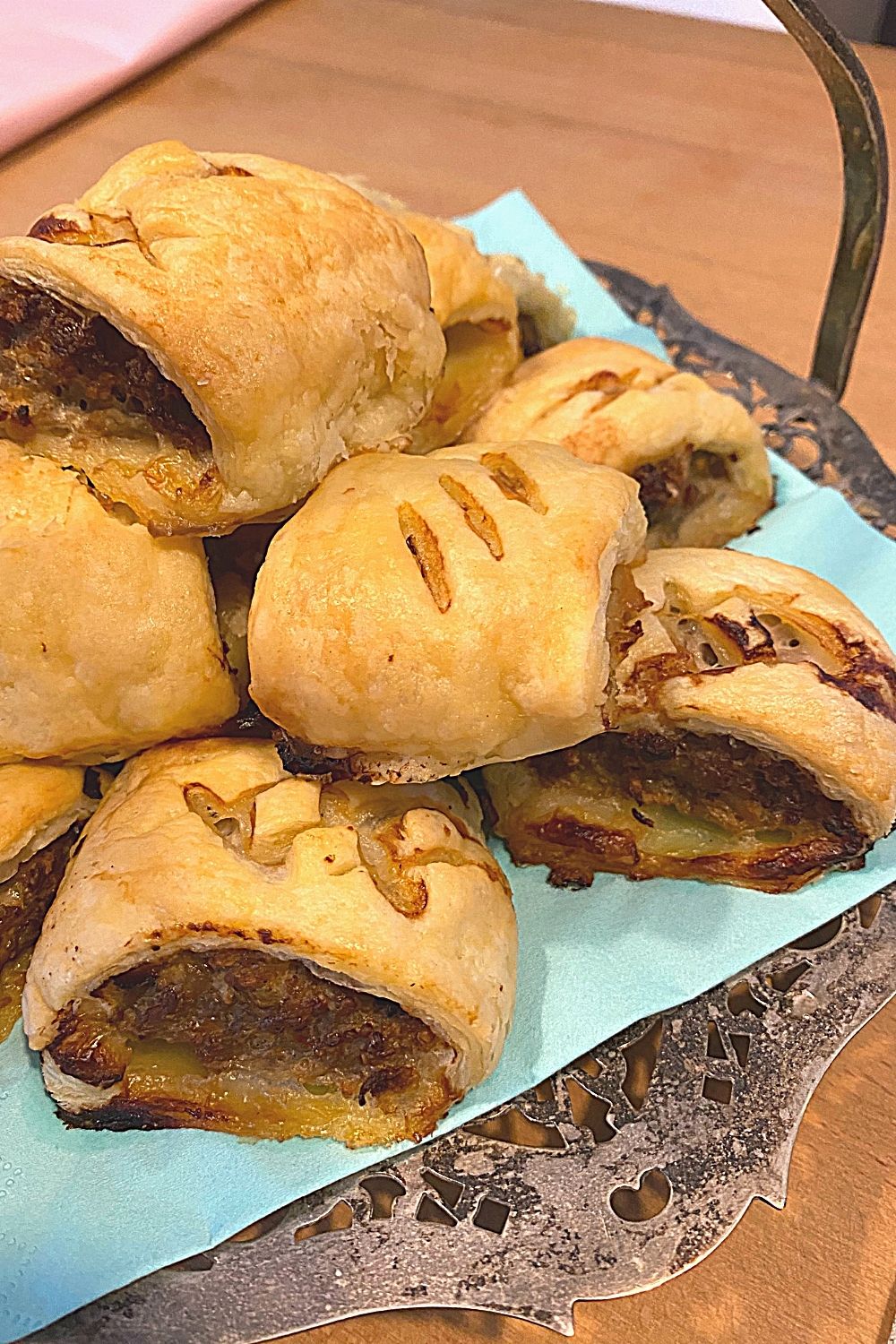Easy featherlight scones: the ultimate London afternoon tea recipe
Featherlight scones with jam and clotted cream are a quintessential element of any English afternoon tea. It was only fitting, therefore, that scones were our recipe for our trip to London. These featherlight scones will elevate your afternoon tea to the next level. And the recipe is so easy to make it is almost foolproof.
Featherlight scones with jam and clotted cream are a quintessential part of any English afternoon tea. It was only fitting, therefore, that scones were our recipe for our trip to London. These easy featherlight scones will elevate your afternoon tea to the next level. And the recipe is so easy, it is almost foolproof.
Disclosure:
Some of the links below are affiliate links. As an Amazon Associate, I earn from qualifying purchases. Please read our full disclosure for more information.
Memories of London
For Mothers’ Day last weekend, I decided to make afternoon tea for Oma and the family. We had some delicious finger sandwiches, mini lemon and lavender bundt cakes (recipes to follow) and, of course, scones with jam and clotted cream. Well, we couldn’t get clotted cream, so we used double cream.

While we were in London, after visiting St Paul’s Cathedral and before some high street shopping, Miss M and I had afternoon tea. It wasn’t at one of the places I wanted to take her – they were booked out – but it was a serendipitous occasion. Neither of us was particularly hungry, so we limited ourselves to an egg salad sandwich and the scones with jam and cream. Miss M decided that the sandwich was not to her liking, but she was quite happy to polish off my scones instead.
When we were having afternoon tea, Miss M remembered having scones in London “at the big church with the bird video” (St Paul’s had a phoenix video intro for their children’s guided tour). It took a little to translate and explain to Oma what she was meaning, but I was happy that she remembered them.

What are scones?
What are scones and why am I referring to them as featherlight scones?
First, it’s pronounced scone as in con, not scone as in cone. I know, it does not really make sense.

Second, what the British and Members of the Commonwealth call scones are not what Americans call scones.
- British scones are closest to American biscuits from look, though the recipe and consistency (and how they are eaten) are totally different.
- Biscuits to the British are cookies to the Brits, like our peanut butter biscuits or the mini Anzac biscuits on our Anzac cupcakes (and there, legally, it is an Anzac biscuit and not a cookie)
- American ‘scones’ are closest to what we call rock scones, rock cakes or rock buns. That is not what you want for afternoon tea! Everything should be dainty, not heavy.
So these featherlight scones are not quite like anything you would find in America.

Almost foolproof featherlight scones
I have tried other recipes, even the lemonade recipe, but this is by far the easiest recipe I have found. It an almost foolproof recipe, unless you are my Grandma.
The recipe comes from the 1970 Australian Women’s Weekly International Cookbook, the same one that has Mum’s apple teacake recipe in it. That fact alone should tell you that the recipe is simple. My Mum only made simple recipes – she didn’t have the patience for anything complex or with too many steps or too much to clean up.
Everyone I know who has made this recipe has had success with it. Even me and I can’t get self-raising flour. Everyone, that is, except my Grandma.

My maternal Grandma is a wonderful artist. An absolutely fantastic artist. Or at least she was before her arthritis made it difficult and frustrating for her. She carved, she sculpted. She painted hundreds of detailed pieces of china and some absolutely glorious silk that she turned into scarves or jackets. She also sewed quite a few wedding dresses and numerous outfits for us when we were kids.
While she was quite well-known for her art, she also became known for her cooking skills, or lack thereof, at least within the family.
For my Grandma, cooking is not relaxing or creative, it is functional and necessary and not at all fun. While she adores desserts, she does not adore making them. She would quite happily live off yoghurt and fruit and the occasional pasty and muddle away in her muddle room.
My Grandfather – who we called Bumpa – enjoyed his food. All food except rice. My Grandma cooked enough to keep him happy, but the food was often uninspired. One of her most famous dishes was WILO or What Is Left Over.

As she didn’t enjoy baking (or any sort of housework really), any recipe had to be simple and foolproof. One day she needed a scone recipe to bake scones for the visiting Dragons (the aunts – not so affectionately known as the dragons – met up regularly for afternoon tea and it was her turn to host). Mum’s was almost foolproof, even for someone who was not a good cook, so that would be the one to use.
My Grandma made this recipe four or five times. Turns out she is the almost. We don’t know how, but each time they turned out like rocks. Not nice rock scones, but inedible solid rocks. The kind where you almost bend your knife trying to cut them open.
That is why I say this recipe is almost foolproof. Because it is, for anyone who is not my Grandma.

The form you have selected does not exist.
Tips for the perfect featherlight scones
This recipe is so easy, you won’t need many tips to succeed.
In some countries, such as Germany, it is difficult to get self-raising flour. It is not available at the supermarket and when you do find it at specialty stores (which specialize in British or American foods), the flour is often older and no longer has much rise.
Don’t worry, we have a simple (and almost foolproof) work around.
To make your own self-raising flour, add two teaspoons of baking powder to each cup of plain flour. For this recipe you need two cups of plain flour and four teaspoons of baking powder. In Germany, use two sachets. Simply sift them into the bowl together. I added half the flour, then two teaspoons of baking powder, then the rest of the flour and baking powder and then sifted. For some other recipes, it might be necessary to sift the flour and baking powder together two or three times to make sure they are mixed well.

Don’t knead your dough for long as this will force out all the air bubbles that are starting to form.
I have a scone cutter that I stole from home (thanks Dad!). It has a little rust, which I didn’t realize until my hands were dirty and I went to use it. For this recipe, I used the largest of the three cookie cutters that I normally use for my Christmas Terraces. Alternatively, use a small glass or cup as your scone cutter. We had a couple that we used frequently at home. I think they originally came filled with mustard.
How to serve your featherlight scones
I am planning a post on how to throw your own afternoon tea, but will be slowly sharing some recipes for that before I do. These so easy they’re almost foolproof featherlight scones will, of course, feature prominently when I do.
Scones should be served with berry jam (my favourite is blackberry) and clotted cream.
What is clotted cream? Also called scalded, clouted, Devonshire or Cornish cream, clotted cream is a thick cream made by heating cow’s milk for a long period in a steam bath and then letting it cool slowly in shallow pans. The cream that rises to the surface upon cooling “clots”. Like butter, clotted cream was originally used as a way to preserve milk, but it is unclear whether it originated in Devonshire or Cornwall (thus the names). There are recipes to make it yourself, such as this one, but I am still looking for the unpasteurized cream.
I have mentioned my dismay with the German creams before. In this case, I didn’t have the time (or the ingredients) to make clotted cream and could not get any at the supermarket. We used double cream instead.

I also just used the jams that we had on hand. So we had ours with lemon curd and my mother-in-law’s homemade red currant jelly. Both were very suitable.
Of course, we will let you decide whether to spread the jam or the cream first. Either way: they taste delicious.
Elevate your afternoon tea with these almost foolproof featherlight scones
No afternoon tea is complete with scones with jam and cream. Whether it is a high tea or afternoon tea, or even just a cream or Devonshire tea, scones feature prominently.
This recipe is so easy, it is almost foolproof (unless you are my Grandma). The light and fluffy, not too sweet texture of these featherlight scones makes this the perfect recipe for your next afternoon tea.
So, when are you having afternoon tea?


Easy featherlight scones
Equipment
- wooden spoon
- baking paper
Ingredients
- 1 egg
- 1 tablespoon sugar
- 30 g 1 oz melted butter
- 3/4 cup milk
- 2 cups self-raising flour
- 1/2 teaspoon salt
- milk for glazing
Instructions
- Preheat the oven to 180°C (360°F).
- In a bowl, beat the egg and sugar until thick.
- Combine the milk and melted butter
- Sift the flour and salt into a box and make a well in the centre. Stir in the egg mixture then the milk mixture and mix until it forms a soft, even dough.
- Turn out onto a floured surface and knead lightly.
- Pat or roll the dough until it dough is approximately 1 1/2 cm high (approximately 1/2 inch) and cut out scones with a floured 2 inch (5 cm) scone cutter.
- Place on a tray that is either lightly greased or lined with baking paper.
- Brush the tops with a little cold milk. Bake for 10 to 12 minutes until risen and the tops are lightly browned.
Notes
Nutrition









Many thanks for this recipe, normally my scones are more like rock cakes and can pass as weapons, but this time I was very happy with the result
That’s wonderful news – weaponized scones are no fun! Glad we could help!
Thanks for posting this recipe that I first made almost 40 years ago!!!
Sharing it today with my elderly parents and my 90 year old primary school teacher. We put out a linen table cloth in honour – and these scones were, indeed, feather light! Wonderful.
That is wonderful to hear! This recipe has never failed me yet. I hope you and your guests had a lovely afternoon tea!
Just made these, they are certainly light in texture. Can you please tell me whether l should fill the cup of flour by pressing down as l found the mix rather wet, did l put in enough flour? Thanks for the receipt for the self raising flour as I didn’t have any to hand today.
Intending to have cream teas in my Bow top caravan next year, we are featured on a TV prog coming out in March, so I’m practising!
Exciting! Afternoon teas in a caravan sound like lots of fun! Congratulations on the TV feature too!
The scone dough is fairly sticky – you need to dust your surface and scone cutter well. You can also try using a medium egg instead of a large one to make it a little less liquid. Otherwise, just make sure you are using the same cup/cup set to measure your ingredients.
I’m an Australian living in the US and these brought me back to scones my nanna would make. Note to anyone in the US making these, you will get a much more authentic fluffy texture and taste if you use the plain flour substitution Racheal suggests and not US Self Rising. US Self Rising has salt added so your scones will be too salty. I also found the US Self Rising to produce more of a biscuit than an English style scone. My second batch with the plain flour and baking powder added were perfect. Thank you Rachael for a great recipe!
Thank you Kari – and thank you for teaching me that US self-raising flour has salt in it! I would not have expected that at all!!
How much of each would you use….of the flour and baking powder?
Hi Sharon,
Popular question! As I told Sheena, to make your own SR flour, add two teaspoons of baking powder to each cup of flour and mix well (I mix it by sifting). With two cups of flour, you’ll of course need 4 teaspoons of baking powder.
Hope they are foolproof for you too!
What’s the measurements of Baking Powder to flour?
Hi Sheena,
To make your own self-raising flour (like I have to here in Germany), add two teaspoons of baking powder to each cup of plain flour. For this recipe, you would need two cups of plain flour and four teaspoons of baking powder. Run it through your sieve/sifter a couple of times to make sure the flour and baking powder are well combined.
Good luck!
I have always used cold butter rather than melted butter. I will try this next week. And now that I know how to make clotted cream—so easy—I will be having it with my scones from now on. Thanks for this easy recipe.
I have been trying to make clotted cream for more than a year, but I have not been able to source heavy (not-ultra pasturised) cream! I know these scones are going to pair well with the clotted cream. I would love to see photos of your afternoon tea!
How far in advance can I make these scones? Or how long are they fresh?
Hi Mari,
These scones really are best if you eat them when the day that you bake them, when they are still warm.
If your are trying to get as much done in advance as you can, wait until they are completely cooled and then freeze them. They should keep for up to a month in an airtight container. On the day that you want to eat them, remove them from the freezer and allow them to thaw out at room temperature for 2 to 3 hours, then refresh them in a moderate oven (about 170°c) for about 10 minutes. Place them on a tray and cover them with aluminium foil to stop the scones becoming too dark as they warm up.
I hope that helps!
Rachael